About a week ago, someone e-mailed me with a question related to my old writing in the pages of the APAs. I’ll get into that query (and answer the question “What the heck is an APA?”) in the follow-up post to this one. Let’s first look at the chain of thought the query inspired.
I have three trunks in my closet. One is empty; for years I used it as an altar for Wiccan rituals. The other two trunks I had not opened in two or three decades. One contained old APAs I’d saved. The other, which I mentioned in my post on wargaming, contained old games.
I felt it was about time to open the trunks and see what was inside. Perhaps the contents had decayed. Perhaps my memory had decayed.
This post is about what I found in the games trunk:
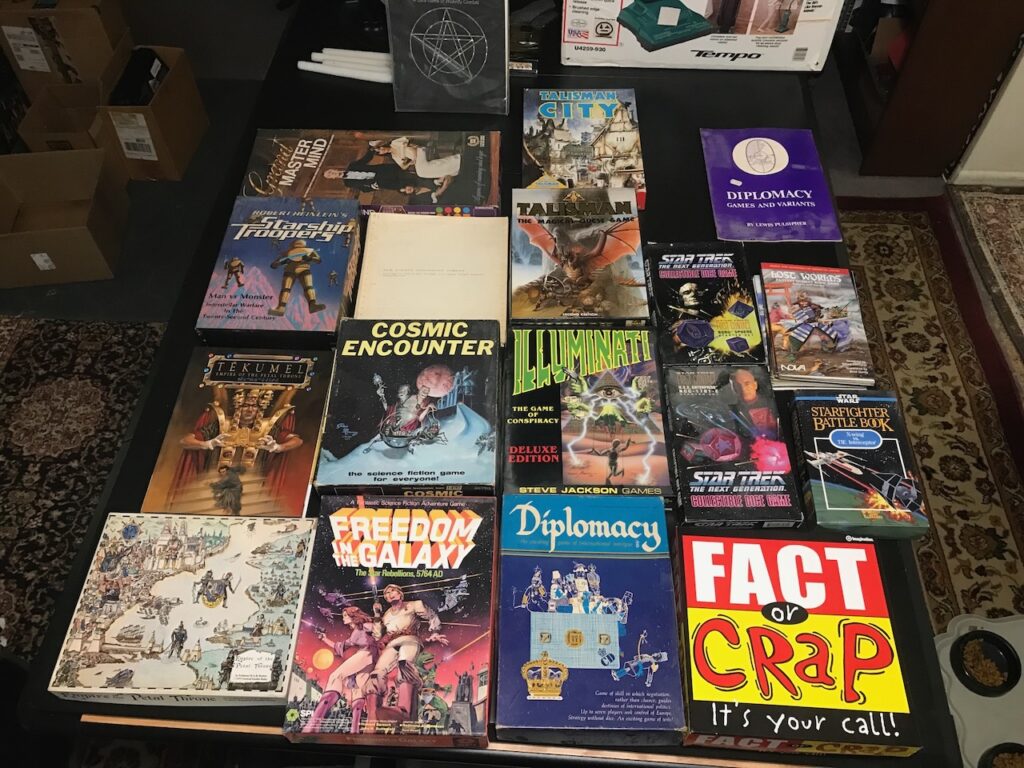
Ah, memories! Here’s what I remember about these games.
Grand Mastermind
I enjoy playing the Mastermind series of games. These are one-on-one puzzle challenges. The standard Mastermind game uses colored pegs; Grand Mastermind includes both colors and shapes. I don’t think I’ve played Mastermind with anyone else since my 50th birthday party, but I’m keeping this one just in case.
Talisman
This is the second edition of the game, plus one expansion.
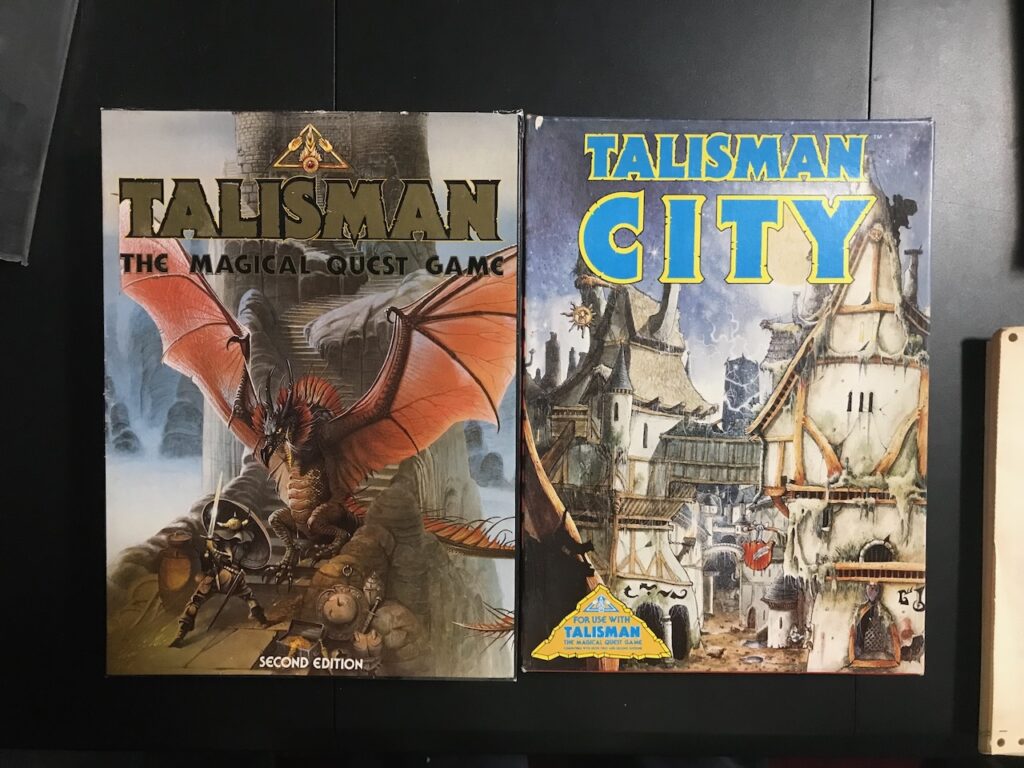
I opened up the main Talisman box for that whiff of nostalgia.

Among my gamer friends, almost none of them care for Talisman. For them, the game is only a small step above Monopoly: You roll a die, move to a space, do what that space says. A couple of my friends (now moved away) liked the game, but only the first edition.
I have the fourth edition with several expansions. It comes with minis and other superior components to what you see in the picture. I’ll be selling this second edition in a future gaming auction.
I keep Talisman around just in case I feel I can entice some folks into the gaming hobby with a heavily-themed game whose rules are fairly easy. The main issue with the game for new players is that it can take two or three hours to play, as is the case with many “D&D-in-a-box” games; it takes time to build up your character to face the final challenge.
Diplomacy
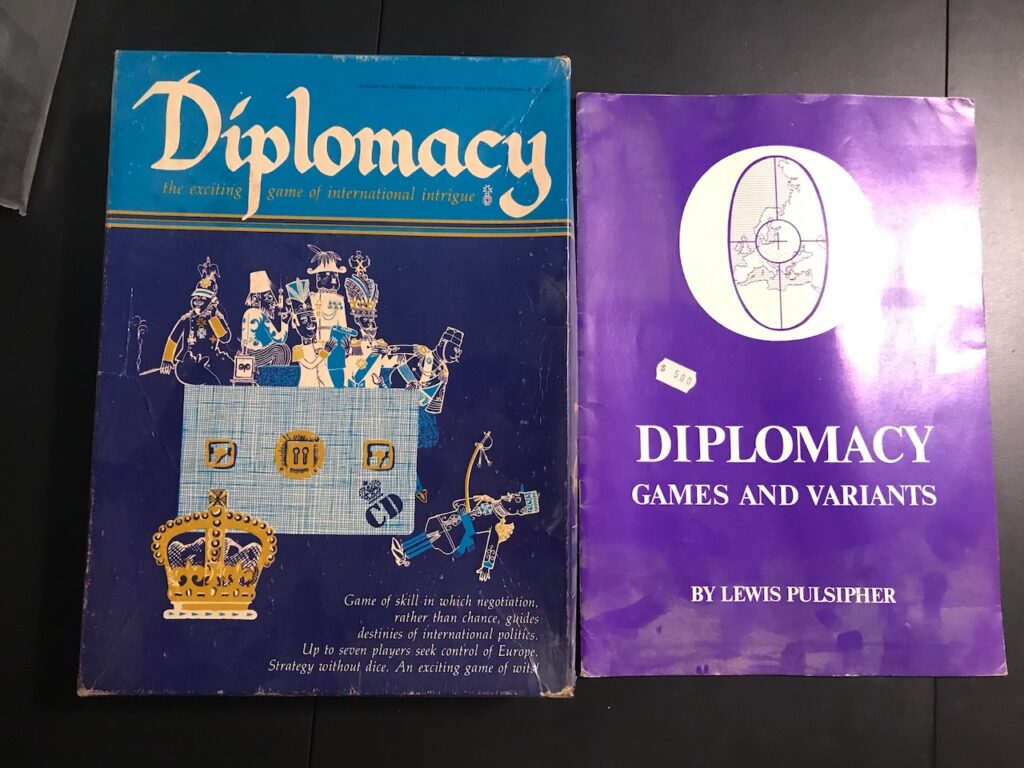
If you search this blog for the game Diplomacy, you’ll find several references.
The game is notorious. In order to win it, you have make alliances, break alliances, make promises, break promises, lie with a straight face, and do all the things that nations do when negotiating with each other. You can make proclamations of your unending friendship with another player to the rest of the group, only to betray that friend five minutes later.
There are rumors of marriages that have broken up because of this game.
The game is still being published. I purchased a copy a few years ago because I’d forgotten I had this one in the trunk. The newer edition has poor-quality components compared the older edition. As you can see in this photo, the old edition had wooden pieces while the new edition has cheap cardboard or plastic bits:
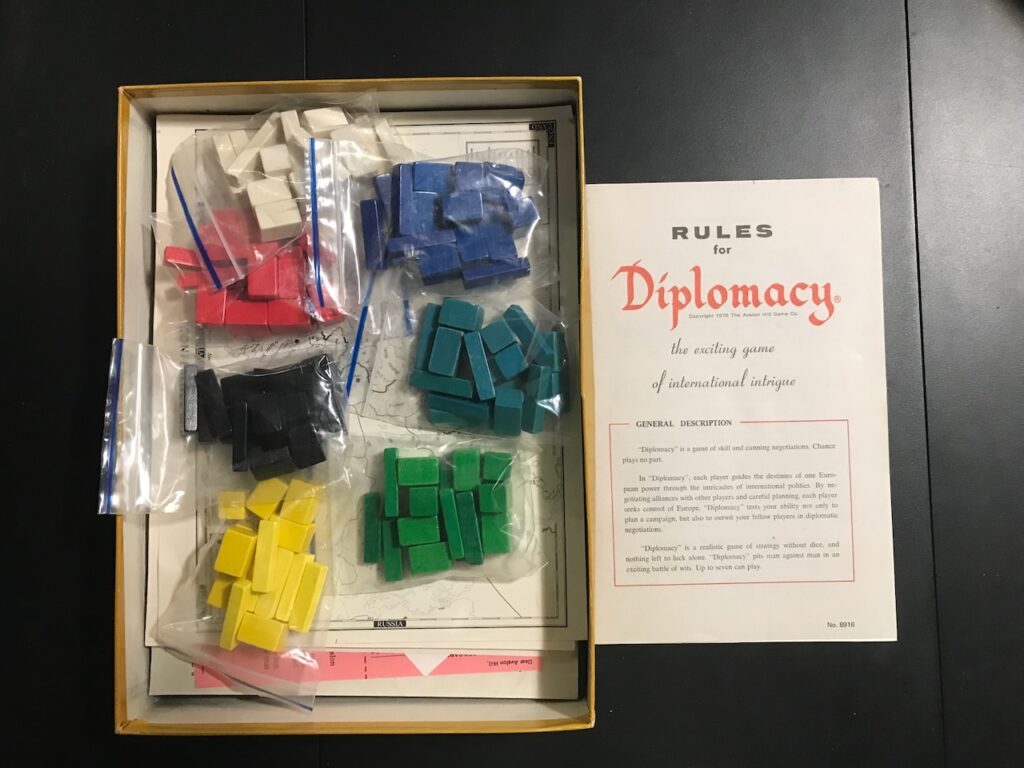
I plan to get rid of the newer edition and keep the older one.
As with Talisman, I know it’s probably foolish for me to keep this game. You need at least five players (the game plays up to seven) in order to have an interesting game. None of my current gamer friends are interested in diplomatic-style gaming; otherwise I would have introduced them to Kingmaker long ago. But I can’t help being sentimental about some of the games in that trunk.
Back in high school, I frequently played Diplomacy with my friends. We played often enough that we became interested in variants of the game to keep things fresh. That’s why I have that purple booklet. If it’s unlikely that I’ll ever play Diplomacy again, it’s even more unlikely that I’ll ever need to worry about variants. Oh, well.
Starship Troopers

My feelings about Starship Troopers are complex.
Most people know the name from the 1997 movie. I read the original book in the 70s. I was (and am) a fan of Robert A. Heinlein, having discovered his juvenile books in the school library. This led me to getting all his books (including his bad ones).
Whether Starship Troopers is one of his good ones is still debated among SF fans six decades later. The story was one of the first instances of military SF. Heinlein tried to paint a realistic picture of armed forces based on sophisticated powered armor. The book influenced later SF writers such as Joe Haldeman and John Scalzi, and such games as Warhammer 40K.
The controversy comes from the description of the human society in the novel. To put it in one sentence: No one was allowed to vote unless they served a term in military service (two years for most; twenty years for those who chose to become officers). Many fans interpreted this as Heinlein supporting right-wing fascism.
Whether that’s true or not I’ll leave to the reader. I’ll note that Heinlein liked to write about many possible future societies, and that it’s unwise to assume that just because an author puts something in a book means that they’re in favor of it.
Anyway, Bill of the 1970s read the book, liked it, and bought the board game based on the book when the game was released in 1976. It was a reasonable adaption of the military tactics described in the book.
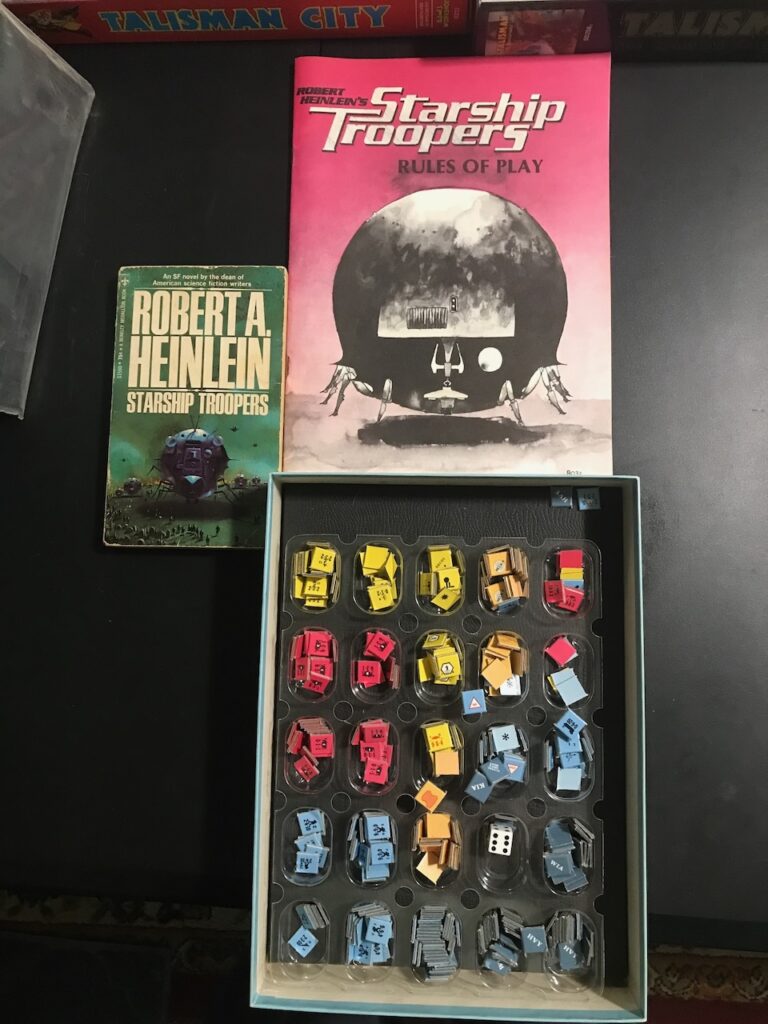
When the Starship Troopers movie came out, I had mixed feelings. It was a decent enough space action flick. I know that Heinlein would have approved of the nudity. But…
The movie stripped all the military tactics from the novel, replacing them with typical Hollywood stupidity. The discussion of a possible future society had been twisted into a parody of fascism. Now, I’m as fond of parodies of fascism as the next sane person (give me The Producers or To Be or Not To Be any day), but the movie’s politics were (a) cartoonish, and (b) making a silly counterpoint to a novel that the vast majority of the audience had not read.
About two decades later, I listened to Starship Troopers on audiobook. I was horrified by the first chapter. The first-person hero, Johnny Rico, is part of a mission to attack what appears to be a civilian target in order to “teach the enemy a lesson.”
When Heinlein wrote the novel, America’s participation in the Vietnam War was in its early stages. The My Lai Massacre (and related war crimes) had not yet occurred. Obviously, 9/11 was in the future.
As a kid, I was a caught up in the military adventure of it all. Fifty years later, the horror of attacking civilians as part of a military conflict has become apparent. I could not cheer for Johnny Rico anymore.
It’s a good game, though.
Oh, well. I still played Paranoia even after a would-be dictator was elected as President to usher in a fascist dystopian future. Sometimes a game is just a game.
Cosmic Encounter
Cosmic Encounter has been around since 1977. I probably picked up this first edition in the late 70s.

The game is still in print, having been reissued in 2007. The later edition has better-quality components. Since I don’t have that later edition, and since I don’t see playing this game face-to-face anytime soon (I’ve played it online a few times in the past couple of years), I’ll stick with the copy I’ve got.

That computer printout next to the game? If you’ve ever played Cosmic Encounter, particularly an early edition like mine, it’s hard to keep from designing new powers. In the late 70s or early 80s, I got together with a couple of friends and we designed new powers for the game. I was bold enough to send these in to the publisher.
To my surprise, they wrote back acknowledging what I’d sent, but explained that they couldn’t accept ideas that came from outside the company. In later years I saw that some of our concepts were in expansions released for the game. However, I attribute that to our ideas being obvious, rather than any influence from us.
I’ve kept the printout solely to remind me of the exuberance of youth. The fact that I had a thing for one of my fellow co-designers has nothing to do with it.
Lost Worlds
Lost Worlds is a fun game idea from the 1980s.
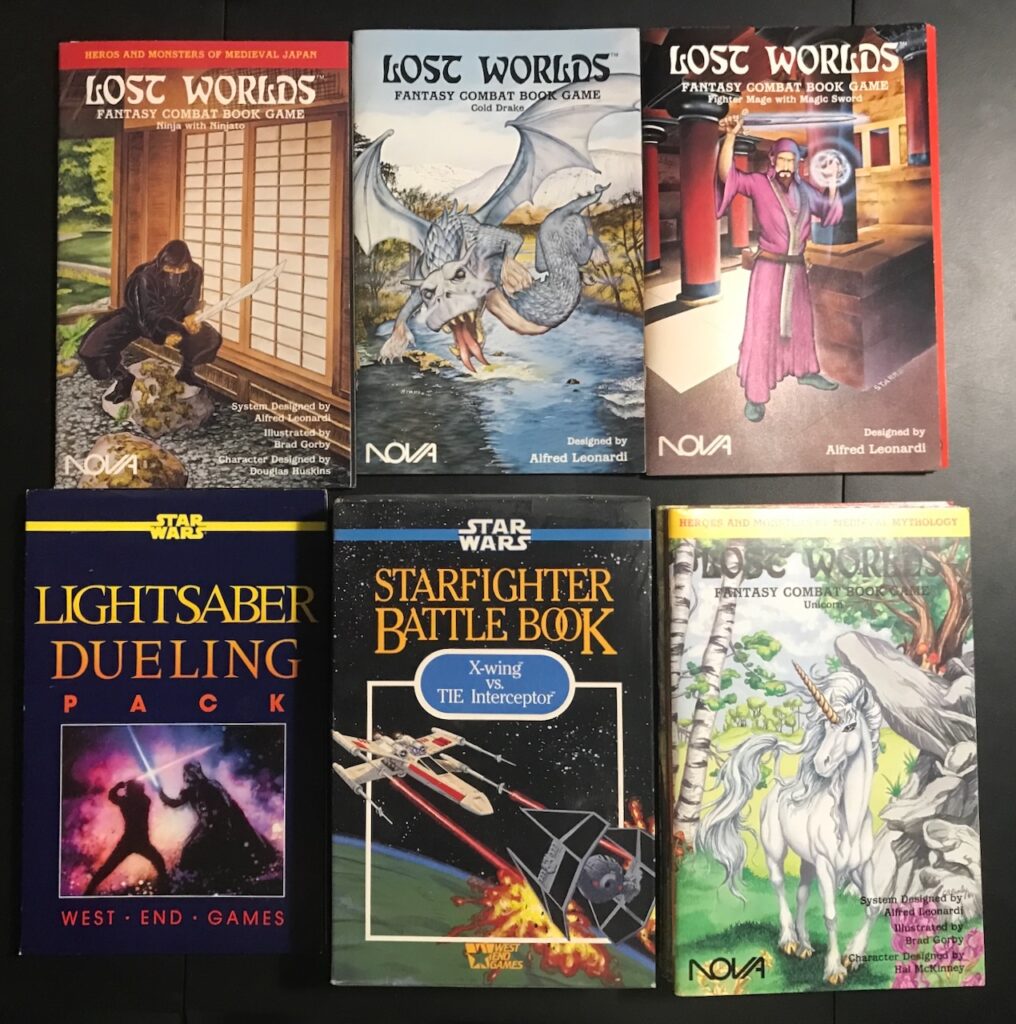
The idea is that you select a character booklet, and a friend selects a different character. You each take out a character sheet from your booklet that lists your combat options and stats. Then you each hand your booklet to the other player.
For the rest of the game, you each state your character’s actions to the other player. They turn to the appropriate page in the booklet according to the action or page number that you just told them.
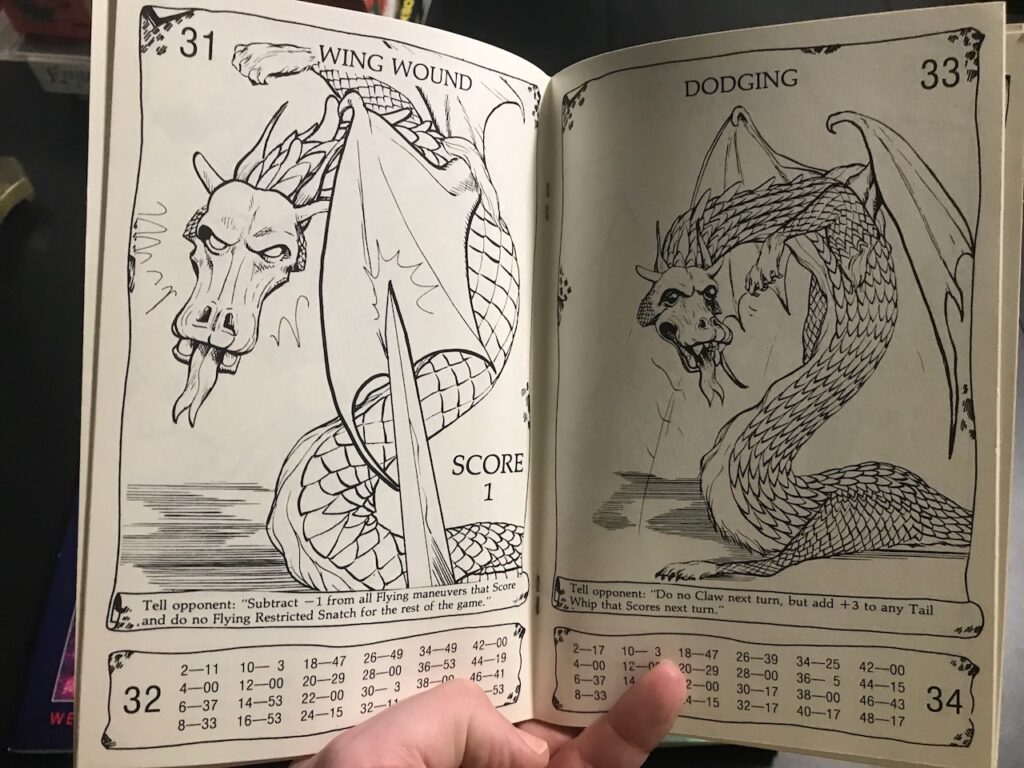
Kids, this is what we had to do in the days before our computers could provide interactive graphics over the Internet.
I have 13 of these booklets in my collection. Sorry, I’ve already given these away to a worthy gamer.
Lightsaver Dueling Pack and Starfighter Battle Book
I’d completely forgotten that I had these.
These are the same concept as Lost Worlds, but applied to the Star Wars universe.
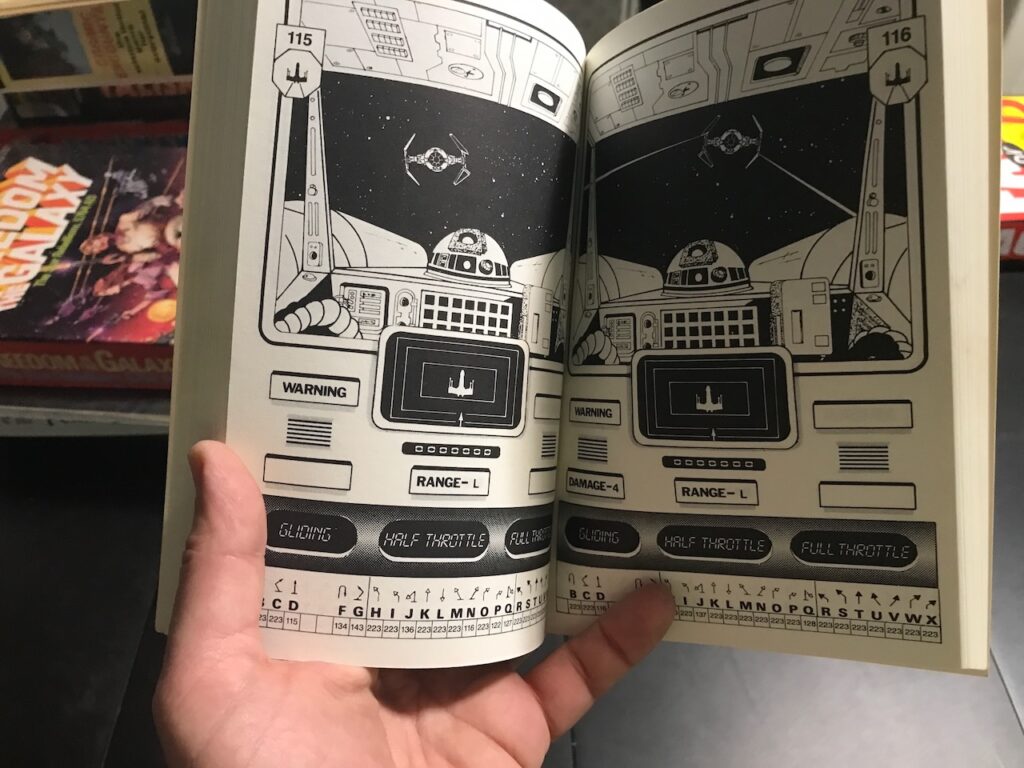
Again, I’ve already passed this on to a friend.
Star Trek: The Next Generation – Collectible Dice Game
I also forgotten that these were in the trunk. When I saw that, decades ago, I’d piled with them with my Lost Worlds games, I thought they were the same kind of game. They’re not.

Instead of being an “image exchange”, these games are console simulators. You update your ship’s status as you battle your opponent.
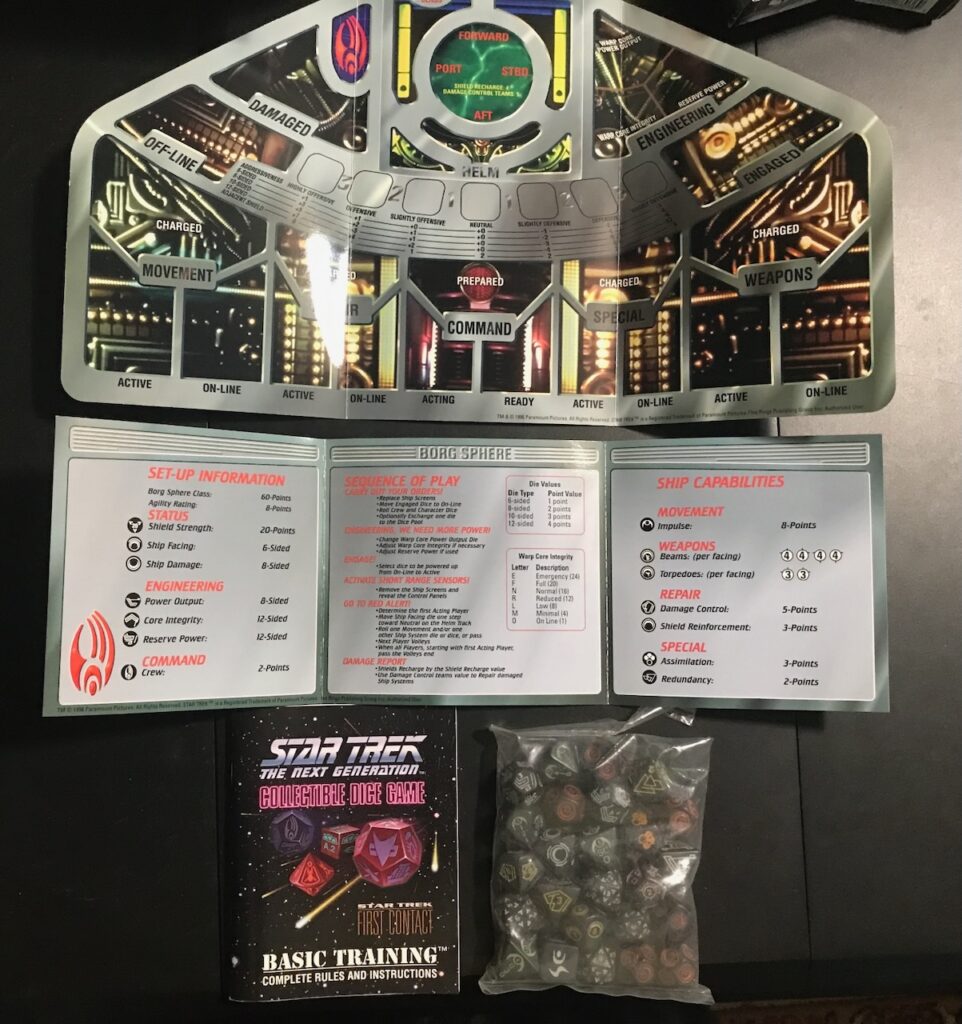
What makes them “collectible dice games”? I’m not sure, and I’m too lazy to look it up. Perhaps it means that more games would be released that used the same concept. Perhaps it meant that there would be expansions that would add more dice to each ship’s capabilities, though the games already come with nice custom dice.
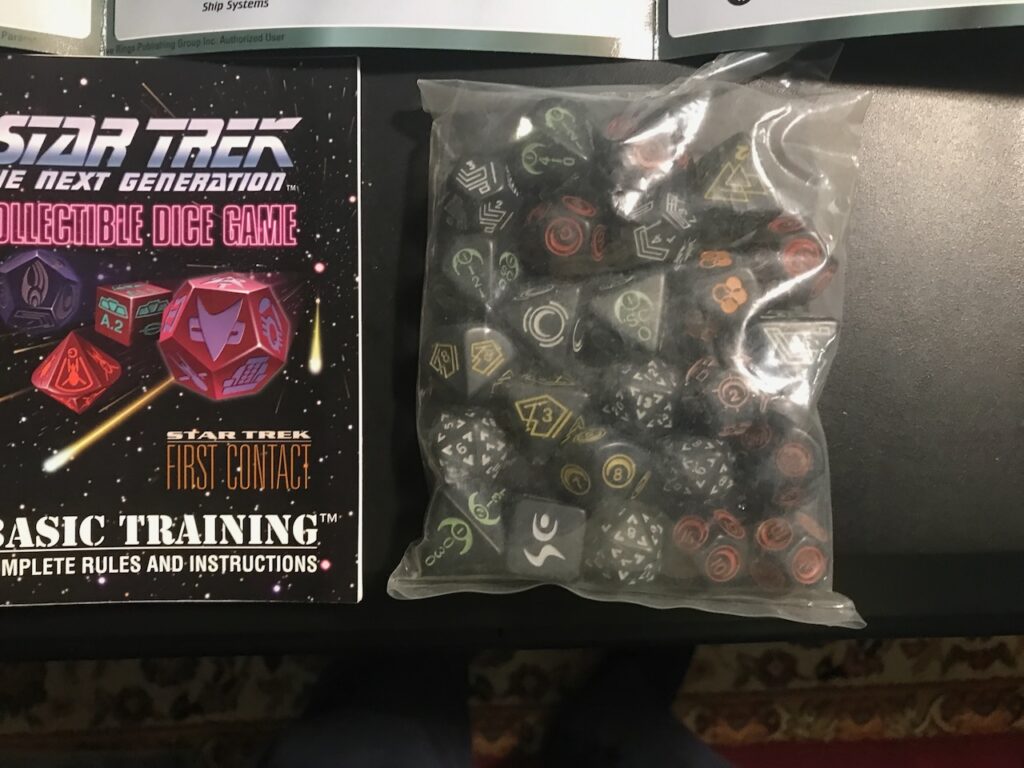
I don’t think I’ve ever played these. Nor did I ever purchase any other “collections” in the series, if indeed any others were ever published.
You’ve guessed it: I gave these away when I gave away Lost Worlds.
Illuminati
I remember playing this and enjoying it, though I recall little about the game’s details. Each player takes on the role of one of the Illuminati, and manipulates various factions in order to becomes the True Masters of the World.

I must have liked the game. When I opened the box, I see at least three expansions.
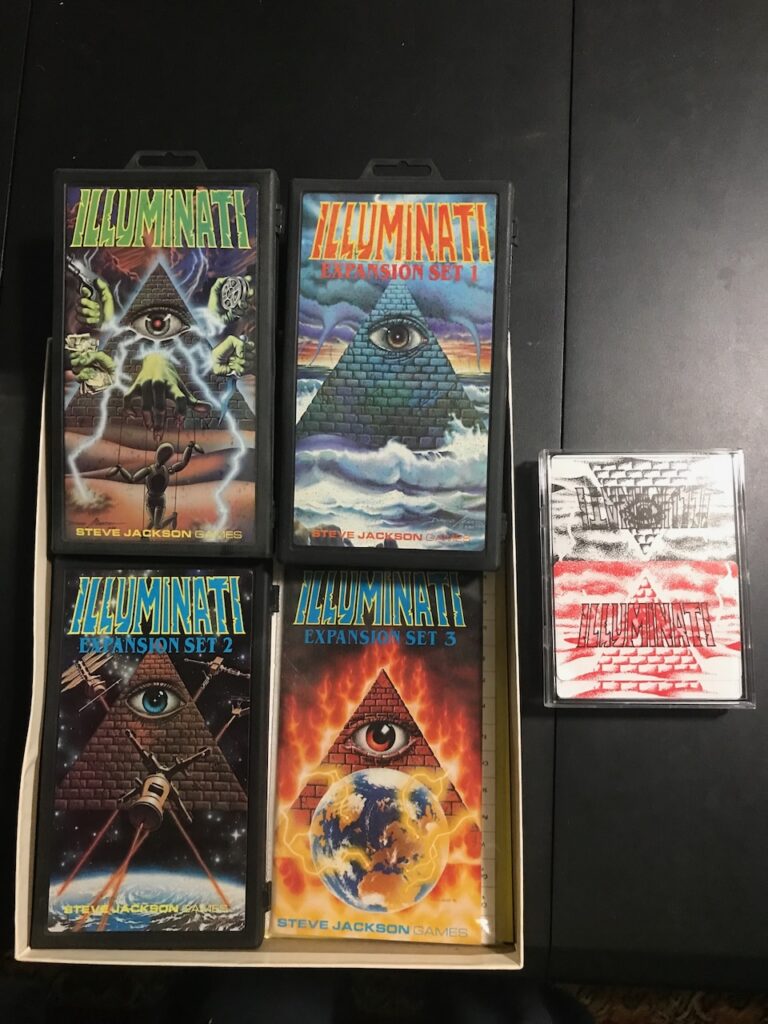
Maybe I’ll get to play this again someday. But you won’t remember it. Fnord.
The Empire of the Petal Throne (and Tekumel Sourcebook)
D&D is generally credited for being the first table-top role-playing game published commercially. The second commercial TTRPG ever published was Empire of the Petal Throne, by M. A. R. Barker. I purchased this game mainly because it came from TSR Hobbies, the publisher of D&D.
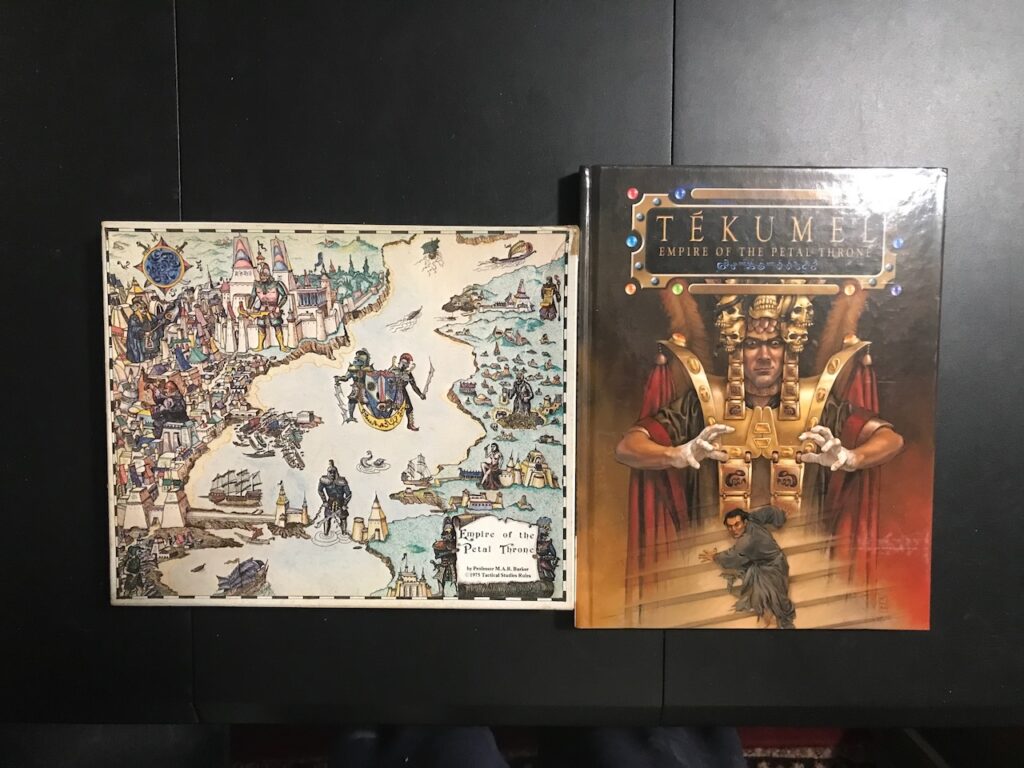
When I got the game, I was floored. The world of Tékumel was a completely original fantasy concept. Most of the others that I’ve seen (including the various campaign settings for D&D, and my own campaign setting Argothald) are warmed-over Tolkien. Tékumel felt different back in the 1970s, and it still feels fresh today.
One of the differences is in the construction of the various languages of Tékumel. Tolkien constructed languages for Middle-Earth, and these languages were based on Western European languages like Finnish. Barker based his languages on Far Eastern and Meso-American sources, such as Urdu and Mayan. This gives a quality of “alienness” to both the spoken and written language that you don’t find in most conlangs.
Tékumel is an ancient world, and Barker’s depictions of the various cultures makes it “feel” ancient. It’s one thing to write that a civilization is tens of thousands years old, it’s another to make that believable through world design. The customs, politics, and economies of Tékumel are all believable in this context. (For another rare example of how this can be done right, compare Gormenghast with… well… practically anything else.)

The original game was basically a re-skin of D&D; all the spells and deities are organized the same way, just with different (and more flavorful) names. In the years since, Barker released versions of Empire of the Petal Throne were not as tied down to the D&D framework.

As you can tell, I’ve been enamored of Tékumel since I first read the world background. It led me to purchase the first couple of books that Barker wrote set in his world. Unfortunately, and in my mind, Barker’s excellence in world design is not matched by his skills as s writer. The Tékumel books are serviceable, but no more.
Empire of the Petal Throne has a sideways connection to another author: Raymond E. Feist. When I read the first book of his Riftwar cycle, I recognized the world of Tékumel immediately. To me, it seemed like theft. In later years Feist acknowledged the inspiration and claimed it was unintentional. Perhaps so, but it poisoned Feist in my mind as a writer. I have not read a single work by him since.
I have never run nor run in a game set in the world of Tékumel; it occupies an obscure enough place in the world of TTRPGs that it’s likely that I never shall. There’s a tiny piece of Tékumel in Argothald, in that a couple of the character names (Q’sayzhnu and H’lepalon) are derived from the language Tsolyáni, the main language of the Empire of the Petal Throne.
Pentacle
What is this? I’m not sure.
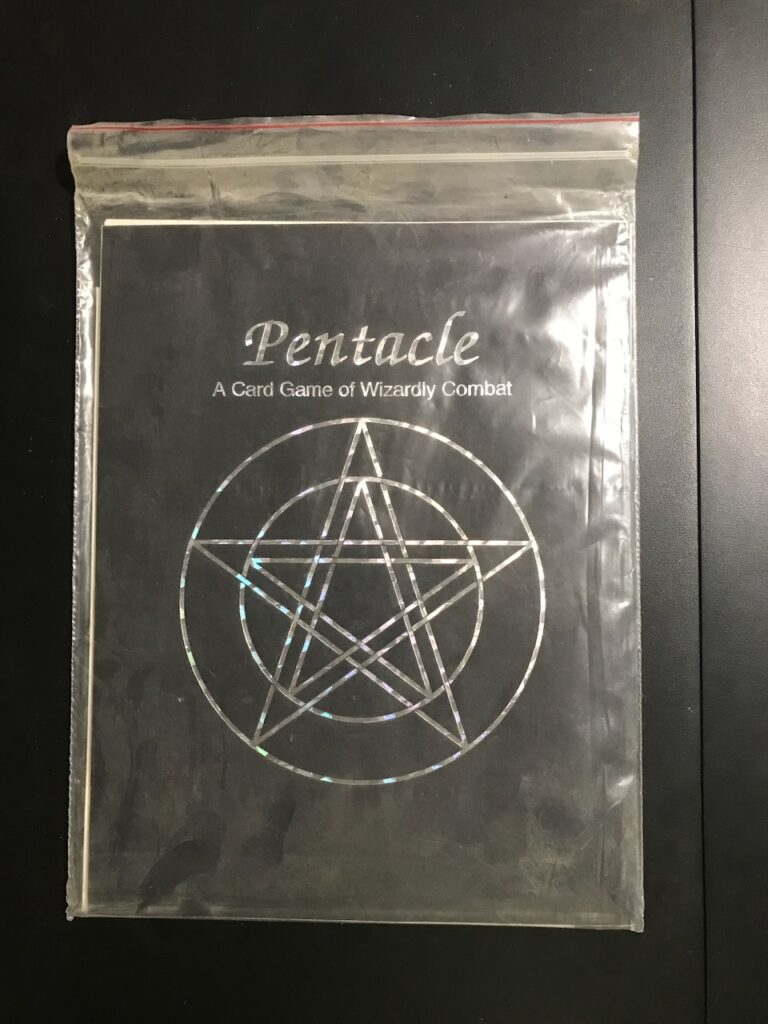
It looks like a small game from a small publisher. I know I’ve never played it, since all of the die-cut cards are still connected together:
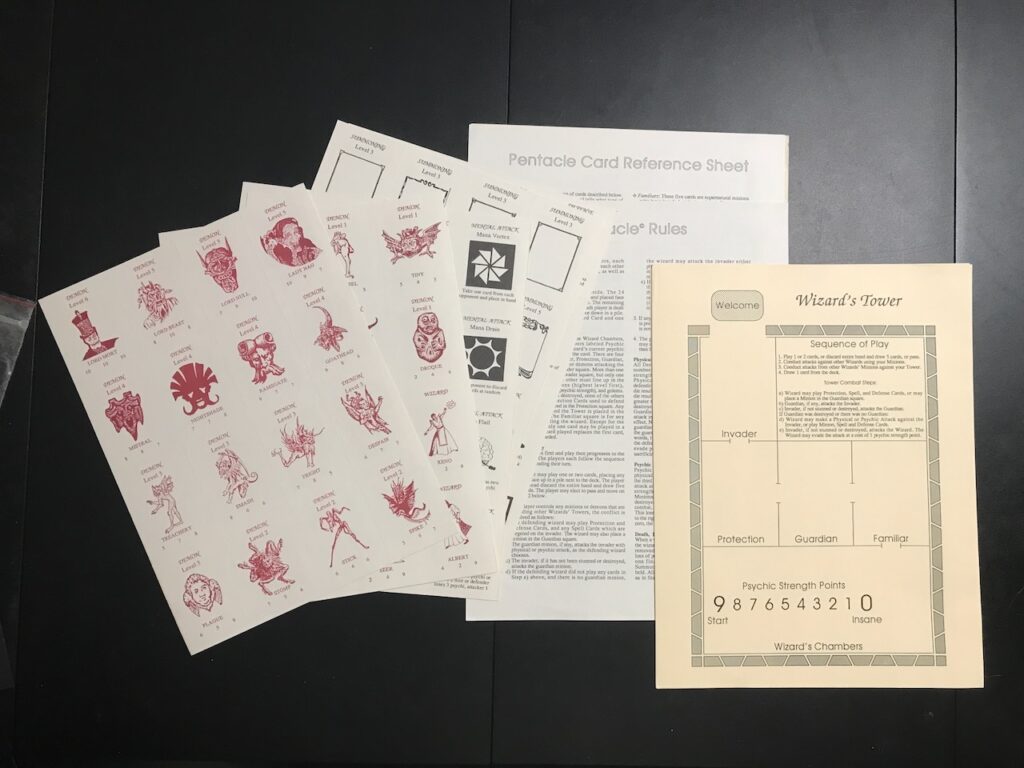
It was published in 1990:
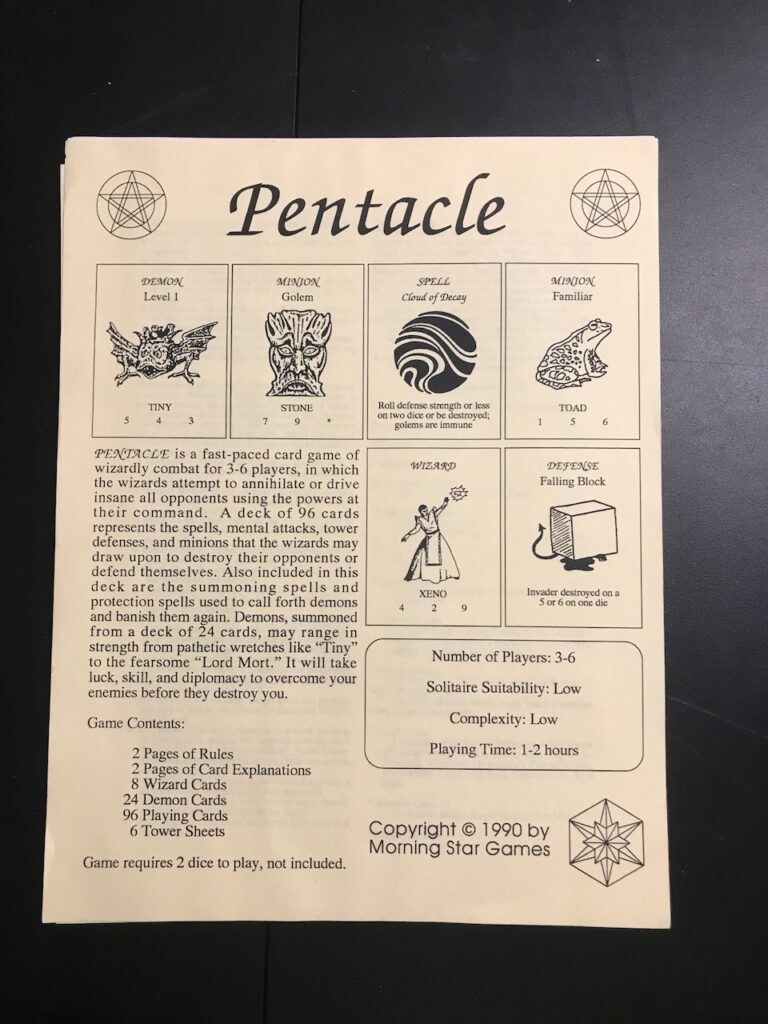
At that time, I was just beginning my explorations into Wicca. I probably purchased it because of the pentacle on the cover.
I don’t know if I’m going sell this, or if I’m going to keep it as a minor piece of gaming history.
Freedom in the Galaxy
I discussed this game in my wargaming post.
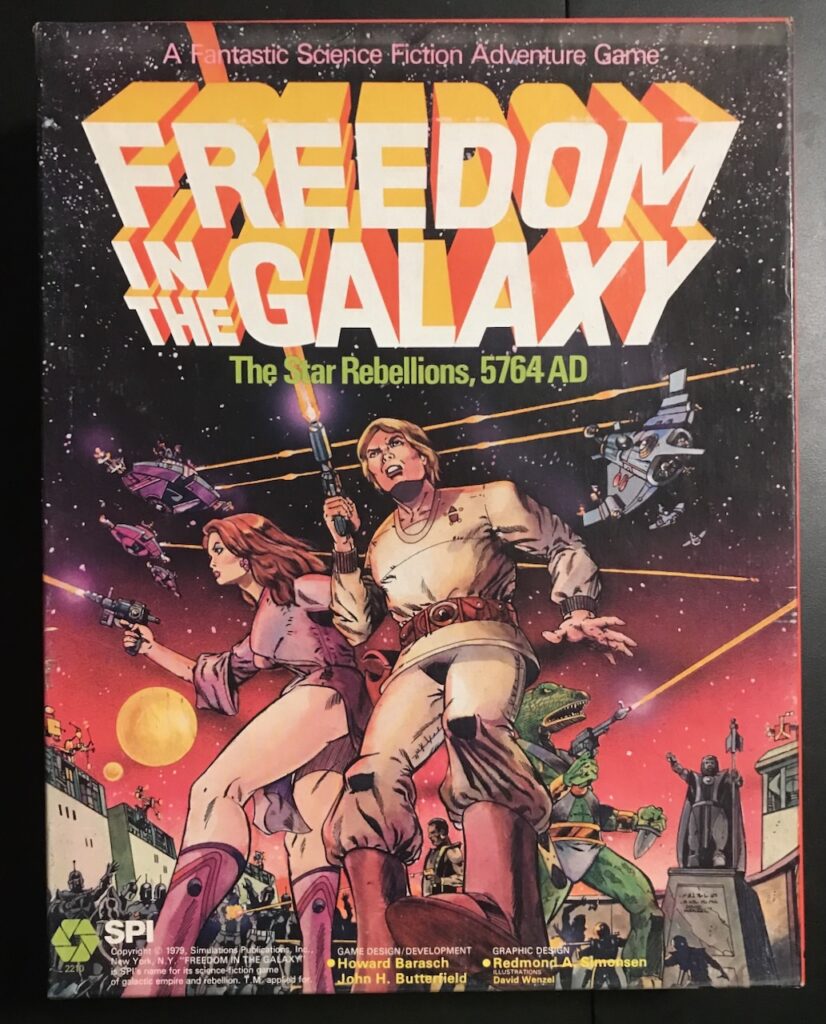
This is the first edition of the game, so it has my name in the credits:

This is another game that I’m not likely to play, since it’s Rebels vs. Empire (remember, no legal resemble to Star Wars!) and I don’t get a chance to play two-player games. Still, I’m keeping it, if only for the memories.
What of the John Carter game that I mentioned in my wargaming post? It wasn’t in the trunk. I must have given it away decades ago. Thus memory makes liars of us all.
Pingback: Opening the Trunks, Part 2 – APAs – The Argothald Journal
Because my ego knows no bounds:
On BoardGameGeek, Andy Kiger has posted an “Unofficial Second Edition Rules” for Freedom in the Galaxy. It not only includes my “Developmental Assistance Credit”, but Player’s Note that I wrote back then and had completely forgotten about until Andy pointed them out to me.
Thanks, Andy!